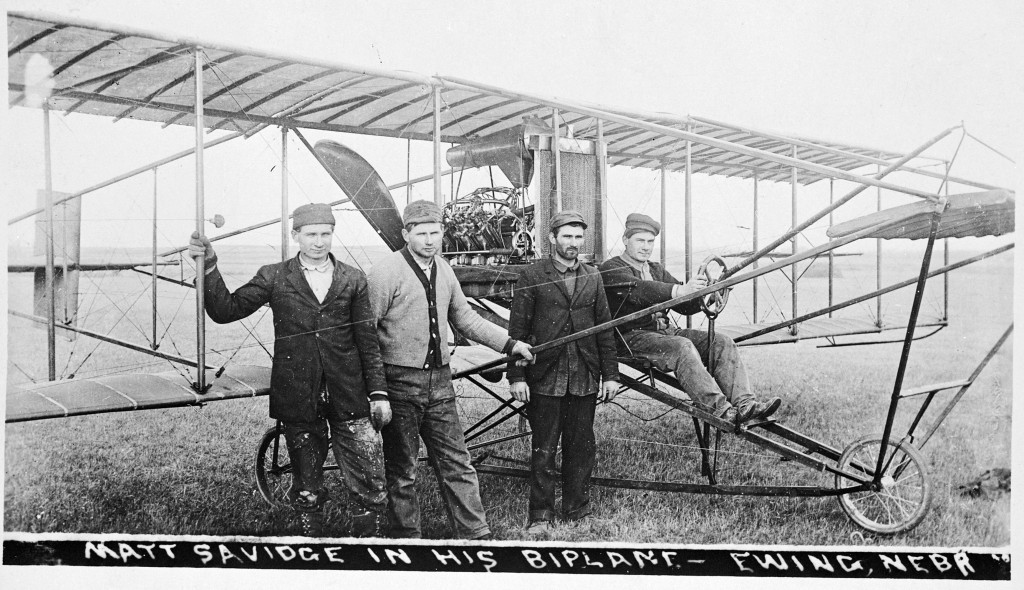
By David L. Bristow, History Nebraska
When Charles Baysdorfer prepared for takeoff near Waterloo, he was piloting a homebuilt biplane on its maiden flight, but he hadn’t taken any lessons or flown in an airplane before. Manufactured planes and professional training were hard to come by in 1910.
On that day, Nov. 21, however, Baysdorfer became the first Nebraskan pilot and the first to fly a Nebraska-built plane. No one who knew Charles and his brothers would have been at all surprised.
The sons of German immigrants, the Baysdorfer brothers — Otto, Charles and Gus — moved with their parents to Omaha from Davenport, Iowa, in 1887. Otto opened a bicycle shop and learned to repair electrical motors. When local merchant Emil Brandeis bought the city’s first “horseless carriage” in 1895, Otto and his younger brothers began designing their own. Built entirely of locally fabricated parts designed by the brothers, the “Ottomobile” was completed in 1898 and became the first Nebraska-built car.
“Instead of a radiator, they had a water tank under the seat,” the Omaha World-Herald reported on Nov. 27, 1910, “and after the car had gone a few miles, this became so hot, that, — well the driver arose and stood up for a time, and let the car stop for a little rest.”
The brothers then designed an engine they could mount on a bicycle — one of the city’s first motorcycles. A World-Herald profile of Otto on March 5, 1933, also credited the brothers with building the city’s first X-ray machine, with operating the “first motion picture machine at the first movie shown here,” and with “inventing a sparkplug, a gasoline gauge and various devices which brought them money and acclaim.”

Charles left Omaha for four years in the early 1900s, touring the country as a balloonist and parachute jumper. The modern parachute harness had not yet been invented. Parachutists of the day straddled a sling and held onto a trapeze bar. Charles’s specialty was the double jump. He would let go of his parachute and free-fall for a few seconds — while onlookers shrieked below — before a second chute opened.
After Charles returned to Omaha in 1907, the brothers built a dirigible airship — yet another Nebraska first. The Comet’s hydrogen-filled silk gasbag was 52 feet long and only capable of lifting one man. Its eight-horsepower engine left it vulnerable to strong winds. Flying above the city on Oct. 3, Charles was swept southward over the Missouri River. Dropping to treetop level, he called to a fisherman below to row out and catch the rope.
“Pull your own damned rope!” the man called back.
Other fishermen were more generous and brought the airship down safely. A few weeks later, the Baysdorfers entered the Comet in an airship race in St. Louis, but its engine failed and the wind carried it to an inglorious landing half a mile off course.
Within a few years, the Baysdorfers turned their attention to airplanes. The aviation craze was in full swing when the first “aeroplanes” flew in Nebraska in 1910. Glenn Curtiss — rival of the Wright Brothers — led a five-day air show July 23-27 in Omaha. On Sept. 6, Arch Hoxsey, of the Wright flying team, crashed his plane into a stable at the Nebraska State Fair in Lincoln, walking away with minor injuries.
The Baysdorfers’ first plane was based on Glenn Curtiss’s design. Otto and Gus worked with the Curtiss mechanics during the Omaha air show, and Curtiss himself visited the Baysdorfer’s shop while he was in town. The brothers built everything but the motor and propeller at their Omaha shop.
After the first flights at Waterloo, Charles and Gus made some other Nebraska flights in 1911, but soon left the state to tour with a nationally known aviation team. Charles was still flying in 1912 when the New York World interviewed his wife, Artye, for a Sept. 7 article “Constant Agony for the Wives of the Aviators.”
By this time, so many prominent aviators had died in crashes that there was serious talk of banning public exhibition flights. Like most adventurers’ wives of the era, Artye expressed confidence in her “sensible” and “cool-headed” husband, even while admitting that “I simply cannot go to the field and watch him go up. … I just have to shut my eyes and clench my fists and keep telling myself that he is all right and that he will come back safely.”
Young women were attracted to pilots, Artye said, but she warned that it was better to admire a pilot from the grandstand “than to keep wondering all the time how long it will be before your only remaining comfort will be to sit dressed in black with nothing but his picture and his press clippings to comfort you!”
A year later, Charles crashed into a mountain in Vermont while doing stunt flying for the movie “The Battle in the Clouds.” His engine failed during a mock bombing run. He suffered burns and a broken leg, but Artye’s worst fears were not realized. Charles survived, gave up flying and became a commercial fisherman in Florida.
“I lost everything when I fell in Vermont nine years ago,” Charles told the World-Herald in 1925. “I was in the hospital six months, and my spine is still out of alignment from that fall.”
Otto and Gus remained in Omaha, where the World-Herald profiled them now and then as local heroes of invention. In a July 10, 1949, interview, Gus told a reporter of Charles’s latest invention: an anti-whirl fishing float that prevented backlash. “Charley … just loves to fish,” Gus said. The daredevil-turned-fisherman died in 1962 at age 84, the last of the Baysdorfer brothers, and having outlived his wife, Artye, by 30 years.
Visit History Nebraska’s website at history.nebraska.gov.
